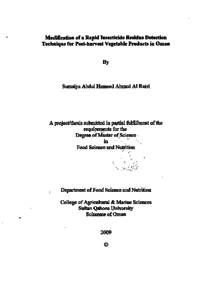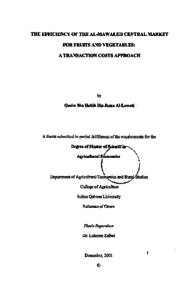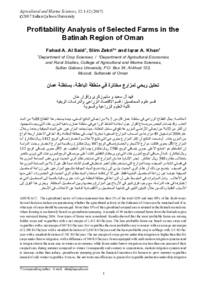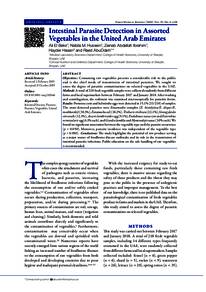Document
Modification of a rapid insecticide residue detection technique for post-harvest vegetable products in Oman.
Publisher
Sultan Qaboos University
Gregorian
2009
Language
English
English abstract
Organophosphorus (OP) pesticides have created a concern due to their residues on agricultural products. Although many analytical techniques have been applied to measure pesticide residues, a rapid method to detect harmful levels of pesticide residues is essential before marketing of any agricultural product. This study was performed in order to suggest a more sensitive and rapid pesticide residue detection technique for OP pesticide residues on vegetable produce in Oman for screening purposes and, also to quantify the concentration of pesticide residues up to certain levels. In this study, the rapid and highly sensitive acetylcholine esterase test i.e. rapid bioassay of pesticide residues (RBPR), that is currently used to detect OP pesticides on vegetables was modified and tested in three stages with known quantities of pesticides namely malathion and diazinon. In the first stage, pesticide determination was done in which the tested pesticide was added to a cuvette directly and no plant leaf materials were used. In the second stage, filter paper substitution was used in which the known amount of pesticide was applied on a filter paper. In the third stage, the controlled plant sample analysis was done in which a known amount of pesticide was applied on plant leaves. After applying the modified test (RBPR) on market samples, it was found that pesticide residues of the Omani vegetable market samples were over the Maximum Residue Limits (MRLs). The results of the current study showed that the developed RBPR technique is sensitive enough to detect positively down to 1.10 ppm concentrations of OP pesticides in plant samples, especially, by using bromine. The technique in its new version is rapid in which the test can be performed within 10 minutes. The technique will help to detect market vegetables with OP pesticide residues above the MRLs and thus the work could be used as a tool for screening vegetables for the presence of pesticide residues.
Member of
Resource URL
Arabic abstract
ان استخدام مبيدات الفسفور العضوية قد أدى الى خلق نوع من القلق بسبب البقايا التي تتركها على المنتجات الزراعية وبالرغم من استخدام طرق التحليل الكيميائي لكشف بقايا المبيدات الا أن هناك حاجة إلى تقنية سريعة الكشف المستويات العالية والمضرة من بقايا المبيدات قبل تسويق أي منتج زراعي. وقد تم انجاز هذه الدراسة لاقتراح طريقة اكثر حساسية واسرع لكشف بقايا مبيدات الفسفور العضوية على المنتجات الزراعية في السلطنة وتحديد ترکيزات بقايا المبيدات في المنتجات الزراعية بالسلطنة. وقد تم تعديل فحص الأسيتيل كولين استراز (Acetyl choline esterase) السريع و المستخدم حاليا لكشف بقايا مبيدات الفسفور العضوية على الخضروات واختباره في ۳ مراحل باستخدام كميات معرفة من بقايا المبيدات ( مالاثيون و دیازینون). في المرحلة الأولى (تقدير المبيد), تم اضافة مبيد معين مباشرة مع عدم استخدام أي اوراق نباتية. أما في المرحلة الثانية فقد تم استخدام ورق الترشيح بحيث تم وضع كمية معروفة من مبيد معين على مساحة محددة من ورق الترشيح. وفي المرحلة الثالثة تم استخدام ورق النبات بدلا من ورق الترشيح وبعد استخدام التقنية المعدلة في كشف بقايا المبيدات على المنتجات الزراعية المحلوبة من سوق الخضروات فقد تم کشف وجود بقايا مبيدات على الخضروات في السوق المحلية بمعدلات تزيد عن الحد الأقصى لمستوى البقايا. وتبين نتائج هذه الدراسة أن تقنية (RBPR) المطورة حساسة بما يكفي لكشف ما يصل إلى تركيز ۱٫۱۰ جزء من المليون من بقايا المبيدات في عينات النباتات وخصوصا مع استخدام البرومين اضافة الى انه سریع بما فيه الكفاية الانجاز الاختبار خلال 10 دقائق. هذه التقنية ستساعد في كشف بقايا مبيدات الفسفور العضوية على الخضروات التي تزيد مستوياما عن الحد الأقصى لمستوى المبيدات(MRLs), وهذا يمكن استخدامها كأداة لكشف بقایا المبيدات على الخضروات وبذلك فصل الخضروات المحتوية على بقايا المبيدات.
Category
Theses and Dissertations





